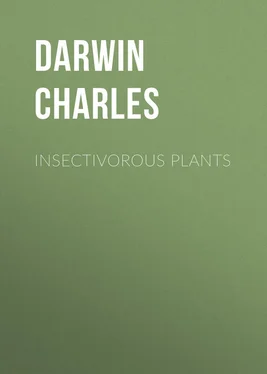Charles Darwin - Insectivorous Plants
Здесь есть возможность читать онлайн «Charles Darwin - Insectivorous Plants» — ознакомительный отрывок электронной книги совершенно бесплатно, а после прочтения отрывка купить полную версию. В некоторых случаях можно слушать аудио, скачать через торрент в формате fb2 и присутствует краткое содержание. Жанр: foreign_antique, foreign_prose, на английском языке. Описание произведения, (предисловие) а так же отзывы посетителей доступны на портале библиотеки ЛибКат.
- Название:Insectivorous Plants
- Автор:
- Жанр:
- Год:неизвестен
- ISBN:нет данных
- Рейтинг книги:5 / 5. Голосов: 1
-
Избранное:Добавить в избранное
- Отзывы:
-
Ваша оценка:
- 100
- 1
- 2
- 3
- 4
- 5
Insectivorous Plants: краткое содержание, описание и аннотация
Предлагаем к чтению аннотацию, описание, краткое содержание или предисловие (зависит от того, что написал сам автор книги «Insectivorous Plants»). Если вы не нашли необходимую информацию о книге — напишите в комментариях, мы постараемся отыскать её.
Insectivorous Plants — читать онлайн ознакомительный отрывок
Ниже представлен текст книги, разбитый по страницам. Система сохранения места последней прочитанной страницы, позволяет с удобством читать онлайн бесплатно книгу «Insectivorous Plants», без необходимости каждый раз заново искать на чём Вы остановились. Поставьте закладку, и сможете в любой момент перейти на страницу, на которой закончили чтение.
Интервал:
Закладка:
Several leaves were left for 4 hrs. 30 m. in a solution of one part of white sugar to 146 of water, and no aggregation ensued; on being placed in a solution of this same strength of carbonate of ammonia, they were acted on in 5 m.; as was likewise a leaf which had been left for 1 hr. 45 m. in a moderately thick solution of gum arabic. Several other leaves were immersed for some hours in denser solutions of sugar, gum, and starch, and they had the contents of their cells greatly aggregated. This effect may be attributed to exosmose; for the leaves in the syrup became quite flaccid, and those in the gum and starch somewhat flaccid, with their tentacles twisted about in the most irregular manner, the longer ones like corkscrews. We shall hereafter see that solutions of these substances, when placed on the discs of leaves, do not incite inflection. Particles of soft sugar were added to the secretion round several glands and were soon dissolved, causing a great increase of the secretion, no doubt by exosmose; and after 24 hrs. the cells showed a certain amount of aggregation, though the tentacles were not inflected. Glycerine causes in a few minutes well-pronounced aggregation, commencing as usual within the glands and then travelling down the tentacles; and this I presume may be attributed to the strong attraction of this substance for water. Immersion for several hours in water causes some degree of aggregation. Twenty leaves were first carefully examined, and re-examined after having been left immersed in distilled water for various periods, with the following results. It is rare to find even a trace of aggregation until 4 or 5 and generally not until several more hours have elapsed. When however a leaf becomes quickly inflected in water, as sometimes happens, especially during very warm weather, aggregation may occur in little over 1 hr. In all cases leaves left in water for more than 24 hrs. have their glands blackened, which shows that their contents are aggregated; and in the specimens which were carefully examined, there was fairly well-marked aggregation in the upper cells of the pedicels. These trials were made with cut off-leaves, and it occurred to me that this circumstance might influence the result, as the footstalks would not perhaps absorb water quickly enough to supply the glands as they continued to secrete. But this view was proved erroneous, for a plant with uninjured roots, bearing four leaves, was submerged in distilled water for 47 hrs., and the glands were blackened, though the tentacles were very little inflected. In one of these leaves there was only a slight degree of aggregation in the tentacles; in the second rather more, the purple contents of the cells being a little separated from the walls; in the third and fourth, which were pale leaves, the aggregation in the upper parts of the pedicels was well marked. In these leaves the little masses of protoplasm, many of which were oval, slowly changed their forms and positions; so that a submergence for 47 hrs. had not killed the protoplasm. In a previous trial with a submerged plant, the tentacles were not in the least inflected.
Heat induces aggregation. A leaf, with the cells of the tentacles containing only homogeneous fluid, was waved about for 1 m. in water at 130o Fahr. (54o.4 Cent.) and was then examined under the microscope as quickly as possible, that is in 2 m. or 3 m.; and by this time the contents of the cells had undergone some degree of aggregation. A second leaf was waved for 2 m. in water at 125o (51o.6 Cent.) and quickly examined as before; the tentacles were well inflected; the purple fluid in all the cells had shrunk a little from the walls, and contained many oval and elongated masses of protoplasm, with a few minute spheres. A third leaf was left in water at 125o, until it cooled, and when examined after 1 hr. 45 m., the inflected tentacles showed some aggregation, which became after 3 hrs. more strongly marked, but did not subsequently increase. Lastly, a leaf was waved for 1 m. in water at 120o (48o.8 Cent.) and then left for 1 hr. 26 m. in cold water; the tentacles were but little inflected, and there was only here and there a trace of aggregation. In all these and other trials with warm water the protoplasm showed much less tendency to aggregate into spherical masses than when excited by carbonate of ammonia.
Redissolution of the Aggregated Masses of Protoplasm. – As soon as tentacles which have clasped an insect or any inorganic object, or have been in any way excited, have fully re-expanded, the aggregated masses of protoplasm are redissolved and disappear; the cells being now refilled with homogeneous purple fluid as they were before the tentacles were inflected. The process of redissolution in all cases commences at the bases of the tentacles, and proceeds up them towards the glands. In old leaves, however, especially in those which have been several times in action, the protoplasm in the uppermost cells of the pedicels remains in a permanently more or less aggregated condition. In order to observe the process of redissolution, the following observations were made: a leaf was left for 24 hrs. in a little solution of one part of carbonate of ammonia to 218 of water, and the protoplasm was as usual aggregated into numberless purple spheres, which were incessantly changing their forms. The leaf was then washed and placed in distilled water, and after 3 hrs. 15 m. some few of the spheres began to show by their less clearly defined edges signs of redissolution. After 9 hrs. many of them had become elongated, and the surrounding fluid in the cells was slightly more coloured, showing plainly that redissolution had commenced. After 24 hrs., though many cells still contained spheres, here and there one could be seen filled with purple fluid, without a vestige of aggregated protoplasm; the whole having been redissolved. A leaf with aggregated masses, caused by its having been waved for 2 m. in water at the temperature of 125o Fahr., was left in cold water, and after 11 hrs. the protoplasm showed traces of incipient redissolution. When again examined three days after its immersion in the warm water, there was a conspicuous difference, though the protoplasm was still somewhat aggregated. Another leaf, with the contents of all the cells strongly aggregated from the action of a weak solution of phosphate of ammonia, was left for between three and four days in a mixture (known to be innocuous) of one drachm of alcohol to eight drachms of water, and when re-examined every trace of aggregation had disappeared, the cells being now filled with homogeneous fluid.
We have seen that leaves immersed for some hours in dense solutions of sugar, gum, and starch, have the contents of their cells greatly aggregated, and are rendered more or less flaccid, with the tentacles irregularly contorted. These leaves, after being left for four days in distilled water, became less flaccid, with their tentacles partially re-expanded, and the aggregated masses of protoplasm were partially redissolved. A leaf with its tentacles closely clasped over a fly, and with the contents of the cells strongly aggregated, was placed in a little sherry wine; after 2 hrs. several of the tentacles had re-expanded, and the others could by a mere touch be pushed back into their properly expanded positions, and now all traces of aggregation had disappeared, the cells being filled with perfectly homogeneous pink fluid. The redissolution in these cases may, I presume, be attributed to endosmose.]
On the Proximate Causes of the Process of Aggregation.
As most of the stimulants which cause the inflection of the tentacles likewise induce aggregation in the contents of their cells, this latter process might be thought to be the direct result of inflection; but this is not the case. If leaves are placed in rather strong solutions of carbonate of ammonia, for instance of three or four, and even sometimes of only two grains to the ounce of water (i.e. one part to 109, or 146, or 218, of water), the tentacles are paralysed, and do not become inflected, yet they soon exhibit strongly marked aggregation. Moreover, the short central tentacles of a leaf which has been immersed in a weak solution of any salt of ammonia, or in any nitrogenous organic fluid, do not become in the least inflected; nevertheless they exhibit all the phenomena of aggregation. On the other hand, several acids cause strongly pronounced inflection, but no aggregation.
Читать дальшеИнтервал:
Закладка:
Похожие книги на «Insectivorous Plants»
Представляем Вашему вниманию похожие книги на «Insectivorous Plants» списком для выбора. Мы отобрали схожую по названию и смыслу литературу в надежде предоставить читателям больше вариантов отыскать новые, интересные, ещё непрочитанные произведения.
Обсуждение, отзывы о книге «Insectivorous Plants» и просто собственные мнения читателей. Оставьте ваши комментарии, напишите, что Вы думаете о произведении, его смысле или главных героях. Укажите что конкретно понравилось, а что нет, и почему Вы так считаете.












